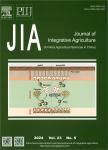Ecology and management of the black inch worm, Hyposidra talaca Walker (Geometridae: Lepidoptera) infesting Camellia sinensis (Theaceae): A review
Ecology and management of the black inch worm,Hyposidra talaca Walker(Geometridae:Lepidoptera) infesting Camellia sinensis(Theaceae):A review作者机构:Department of Entomology Tocklai Tea Research Institute Tea Research Association Jorhat 785008 India Entomology Research Unit Department of Zoology University of North Bengal Siliguri 734014 India
出 版 物:《Journal of Integrative Agriculture》 (农业科学学报(英文版))
年 卷 期:2017年第16卷第10期
页 面:2115-2127页
核心收录:
学科分类:09[农学] 090401[农学-植物病理学] 090402[农学-农业昆虫与害虫防治] 0710[理学-生物学] 0832[工学-食品科学与工程(可授工学、农学学位)] 0830[工学-环境科学与工程(可授工学、理学、农学学位)] 1004[医学-公共卫生与预防医学(可授医学、理学学位)] 0905[农学-畜牧学] 0906[农学-兽医学] 0904[农学-植物保护] 0901[农学-作物学] 0703[理学-化学] 0902[农学-园艺学] 0713[理学-生态学]
基 金:The authors extend their gratitude to the National Tea Research Foundation (NTRF) Tea Board Government of India for extending their support on integrated management of Hyposidra talaca in tea plantations in project mode
主 题:Hyposidra talaca black inch worm tea bionomics resistance integrated pest management (IPM)
摘 要:The black inch worm, Hyposidra talaca (Walker) (Geometridae: Lepidoptera) has earned considerable importance as a defoliator during last decade in north east India. Characteristic features of H. talaca, Such as switching from wild plants to Camellia sinensis, and completion of 6-8 generations in a year without winter diapause appear to be the major reasons for persistence of the defoliator on C. sinensis. There are reports on the aggressive infestation of the pest on C. sinensis than on alternate host plants and development of high tolerance^resistance to certain insecticides. Till date, more than one hundred alternate host plants have been recorded for H. talaca, but with very few natural enemies. To manage this pest chemically, synthetic pesticides are widely used. Integrated management is recently being encouraged wherein cultural, mechanical, physical, biological and chemical methods have been contemplated. This review collates the work and literature on the ecology of H. talaca and offers an analysis of the problems encountered in managing the defoliator in tea plantations. Further, future directions for better management of H. talaca are suggested.



